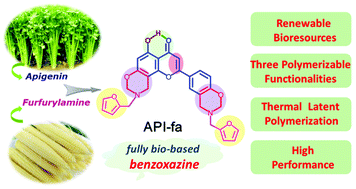An apigenin-based bio-benzoxazine with three polymerizable functionalities: sustainable synthesis, thermal latent polymerization, and excellent thermal properties of its thermosets†
Abstract
Benzoxazine resins have been attracting continuous attention from both academia and industry owing to the property of molecular design flexibility and high performance of their thermoset polymers. However, a reduction in the polymerization temperature, a renewable source and improved thermal and mechanical properties are highly desirable in order to meet the requirements of various applications. Herein, we have synthesized a new bio-based benzoxazine resin showing thermal latent polymerization characteristics from renewable apigenin and furfurylamine. This benzoxazine resin possesses the advantage of long shelf life as do other traditional benzoxazines through its intramolecular hydrogen bonding between the phenolic –OH and the carbonyl. In addition, it can be polymerized via multiple polymerization mechanisms rather than the single polymerization mechanism as reported for other traditional benzoxazines. Moreover, the fully polymerized thermoset derived from this bio-based benzoxazine exhibits a high glass transition temperature of 376 °C, a very high char yield of 66%, and an extraordinarily low heat release capacity of 20.2 J (g K)−1. Its excellent thermal performance and flame resistance evidence its great potential applications in fields where high-performance materials are needed.



 Please wait while we load your content...
Please wait while we load your content...